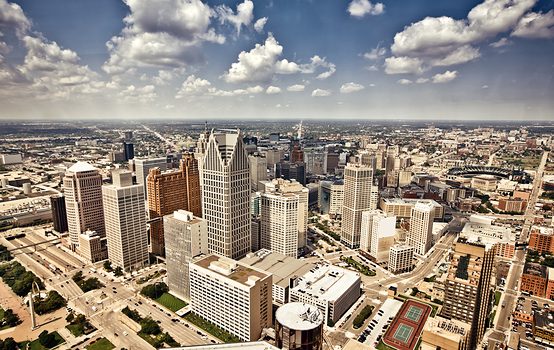Detroit Never Died

In the 1950s, on a per capita basis, Detroit was the richest city in America. The Broadway-Capitol Theatre offered showings of Casablanca in palatial Renaissance décor. The Detroit Institute of Arts Museum boasted one of the world’s greatest collections, including works by Picasso, van Gogh, and Matisse. The city’s vibrant downtown was populated by soaring Art Deco skyscrapers, burnished with sculpted ornamentation.
With a city plan derived from L’Enfant’s master plan for Washington, DC—which in turn was modeled on France’s capital city—Detroit truly was America’s Paris. And with its array of factories adapted into the “arsenal of democracy” supplying Eisenhower and Patton’s efforts to liberate the Continent from Nazi occupation, the “Motor City” repaid its symbolic debt with interest.
Seventy years later, Detroit was already decades into its identity as the American City That Failed, which culminated in its declaration of bankruptcy on July 18, 2013. Michigan governor Rick Snyder then appointed an emergency manager who would usurp the power of Detroit’s elected officials in an effort to do for the city what it had apparently been unable to do for itself. The image-blogging service Tumblr made its name, in part, through a cottage industry of Detroit “ruin porn”: an unending series of artistically taken photographs of the fields of empty former neighborhoods, the factories rusted out, the homes decades since stripped from the inside out for any precious metals in their wiring and pipes. A small number of artists started to head into Detroit, drawn by low property values and the prospect of a “blank slate” onto which they could project their creativity, and the New York Times took notice in breathless profiles of hipster-creative colonialism.
This year, though, a different sort of immigrant gathered in Detroit, albeit only for a week: the 24th Congress for the New Urbanism brought together 1,500 city planners, real estate developers, architects, and journalists to learn from Motown’s tantalizing efforts to rebuild itself.
Literally the biggest part of Detroit’s rebuilding, the restoration of its downtown, is the best known, as it has its own press office. Detroit native and home-mortgage billionaire Dan Gilbert returned to his home city to invest in it and has been leading efforts to resurrect the once-proud downtown into a compelling place to do business. Gilbert poured money into buying the Art Deco and Beaux Arts skyscrapers that Detroit could never afford to tear down when the rest of the country’s great cities were replacing their ornamented skylines with sheer glass geometries. He has moved his Quicken Loans company into that same area, putting his business where his philanthropy is. He provides private security that patrols downtown Detroit around the clock to give a sense of order, and he continues to invest in downtown place-making in areas like the Campus Martius plaza, bordering the Detroit Institute of Arts.
At a time when the city itself is in bankruptcy court, large private investors like Gilbert are providing the public services that government stopped supplying. They are even helping to build a streetcar line on Detroit’s main boulevard, Woodward Avenue. Gilbert and his peers—such as Mike Ilitch, the Little Caesar’s pizza magnate and owner of Detroit’s Red Wings and Tigers; and Manuel Moroun, the owner of the Ambassador Bridge connecting Detroit and Windsor, Ontario—have been controversial figures, given the natural suspicions of Detroiters toward outsiders with big plans for their city. But almost all of the Motor City’s residents acknowledge that even if Gilbert is looking to make a profit, he is also adding value to the place where they live.
♦♦♦
Far from Gilbert’s newly built-up downtown, though, on the northwestern edge of the city, is a set of neighborhoods known collectively as Grandmont Rosedale. Originally streetcar suburbs, Grandmont Rosedale was among the last areas incorporated into Detroit proper before a change in Michigan law effectively prohibited annexation. Built by GM and Ford as model neighborhoods with which they could lure executives from New York, the neighborhoods are a model of 100-year-old Tudor and colonial single-family homes, in a walkable neighborhood structured around parks, schools, and other civic centers. The area is proof positive that sound neighborhood design doesn’t require towering apartment buildings: effectively planned low neighborhoods can meet all the requirements of a humane place on their own.
Grandmont Rosedale doesn’t have Dan Gilbert, however. All its residents have is each other.
In 1989, those residents formed the Grandmont Rosedale Development Corporation, a nonprofit designed to restore the decaying homes of their neighborhood to their once proud condition. Since then, the GRDC has renovated and resold 100 vacant properties in its neighborhood, while also organizing security volunteers, neighborhood beautification projects, a community garden, and a weekly farmer’s market. The GRDC’s latest project has been to engage in the commercial redevelopment of the area, for while the neighborhood is very walkable along residential streets and through the collectively managed parks, Grand River Avenue, the major roadway cutting through the neighborhood, has been less idyllic.
The GRDC bought and renovated a retail space on the main thoroughfare and sold it to local resident Susan Murphy at an affordable price so that their neighborhood could have a locally owned bookstore. Murphy has had to hustle to stay afloat, doing half her business out of the trunk of her car as she does pop-up book sales at events around the city, but she is committed to Grandmont Rosedale and to making it her home. A local coffee shop called Always Brewing developed along the same lines, with proprietor Amanda Brewington telling the City Living Detroit website, “I was looking for a place for my business but also a place where I could be an actual resident. I was attracted to Grandmont Rosedale because of how much people work together to really get things done.” In fact, Murphy’s Pages bookstore was born as a pop-up inside Always Brewing.
The GRDC recently recruited what it calls the area’s first sit-down restaurant, a franchise of Detroit Vegan Soul, an African-American-owned, award-winning eatery started in the West Village. They also run one of Detroit’s few incubator spaces for start-up companies—outside of Gilbert’s bustling downtown—which rents a place at a table for $75 a month and offers six-month “springboard” leases on a 300-square-foot storefront area: small enough for local entrepreneurs to afford so they can launch themselves into regular business.
As North Rosedale native and New Yorker writer Rollo Romig wrote in 2014, none of this energy is new to the area. North Rosedale has always been a holdout against the rest of the city’s decline, thanks to a tight civic fabric that attracts new residents with a similar mindset to the old: an investment in this damn place. Romig’s family stayed and shook off the crime that crept into their neighborhood over the course of the 1980s; eventually they stopped replacing the bicycles that were stolen as soon as they were brought home. They went to Mass, as did most of the neighborhood, and they invested in the panoply of community associations centered around the Community House in central North Rosedale. While Detroit burned, North Rosedale hung on.
“What North Rosedale really gave us was an occasion to rise to,” Romig reflected—and an instinct to gather and join forces against civic unraveling. “Community is a reflex that’s sharpened by necessity,” he wrote. And while crime in the ’90s eventually got bad enough that his family moved out, their efforts along the way were part of what sustained the Rosedale neighborhood through the hardest years and provided the foundation upon which the GRDC continues to build.
Hearing stories like these, you realize why Detroit natives react so viscerally against well-meaning outsiders wandering into their city and marveling at its potential as “a blank slate.” There are a lot of empty lots in Detroit, perhaps even more vacant buildings, but there’s nothing “blank” about the Motor City’s slate. Much of the city is still as bad as its reputation, but there’s always one grandma keeping her house up at the end of the block, preventing that street from being consumed by the emptiness.
And in neighborhoods like Grandmont Rosedale and many more areas even less financially stable, there have been residents fighting every day to keep their city. When Rolling Stone writer Mark Binelli moved back to Detroit, he had a neighbor instruct him, “This is where we live. … If you see someone pissing on that wall over there or trying to break into a car, you need to chase them down.”
To a degree its reputation belies, Detroit has kept its civic spirit intact, even through the 1980s, when Devil’s Night arson would light the city in every direction on Halloween eve. It was the residents who put out those fires, and starting in 1995, 50,000 citizens walked the streets to protect their neighborhoods from being burned by vandals.
 The residents who stuck it out, who walked those Angel’s Night patrols, are finally seeing the decline start to lift. Even as their city proceeds through bankruptcy and an emergency manager overrules their elected officials, 2016 is expected to be the first year in over 60 years that the city of Detroit will increase in population. Wayne County, where Detroit and some of its suburbs are located, has now experienced five straight years of job growth.
The residents who stuck it out, who walked those Angel’s Night patrols, are finally seeing the decline start to lift. Even as their city proceeds through bankruptcy and an emergency manager overrules their elected officials, 2016 is expected to be the first year in over 60 years that the city of Detroit will increase in population. Wayne County, where Detroit and some of its suburbs are located, has now experienced five straight years of job growth.
Detroit’s official motto is, incredibly, Speramus meliora; resurget cineribus—“We hope for better things; it will arise from the ashes”—written by Catholic priest Gabriel Richard in the wake of the 1805 fire that nearly destroyed the city. Detroit has burned at least four times, in fact, but each time it has arisen.
In neighborhoods like Grandmont Rosedale, Detroit’s post-industrial wasteland is once again starting to show green shoots of hope pushing up in concentrated communities that maintain themselves. They preserved the built inheritance of America’s Paris. They hoped for better things, and now they are starting to see them.
Jonathan Coppage is visiting senior fellow at the R Street Institute and a contributing editor at The American Conservative. This article was supported by the Richard H. Driehaus Foundation.
Comments